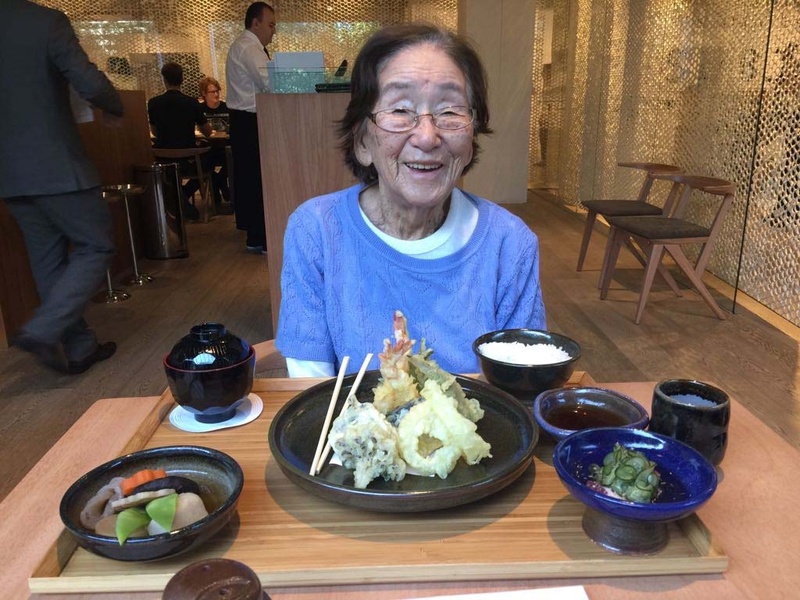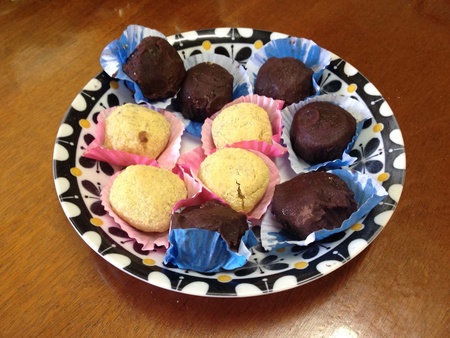The life of Ms. Aiko, a pleasant and hyperactive obatiam who, to this day, at age 96, provides a lesson in vigor and joy of living, would serve very well as inspiration for a book. She was even the subject of a brief article in this newspaper last July, in addition to having been interviewed by the Japanese TV station NHK and the French newspaper Le Monde. Besides, she has been mentioned in several publications.
Having lived in Brazil for 90 years and for more than 60 years in the city of São Paulo, Ms. Aiko has other qualities that could be highlighted alongside her longevity; but at the moment I would like to concentrate on one of them, which is always pointed out by the people who have known her for a long time: her cooking skills.
With the simplicity that is one of her character traits – and without having ever taken a special culinary course and having had only a basic education – Ms. Aiko has a knack and an ability to prepare dishes reminiscent of homemade cuisine: familiar, not always very sophisticated, but appealing and captivating because they’re part of our daily lives. It's that everyday rice and beans; that lean steak with onions, fries, and a tossed salad. On Sundays, whenever possible, some light feijoada [black bean stew], with little fat; lasagna and that delicious little pastel [small, fried thin crust pie with assorted fillings], with the dough prepared from scratch, holding a secret that somehow gives these delicacies a unique flavor. And on special occasions, a pork roast that, considering the aroma it exudes, makes us think right away of a ham sandwich with arugula leaves. Who could possibly resist it? And those little cod fish cakes, breaded shrimps, pork chops!!! I believe that the secret isn’t found only in the spices, but rather in the magical hands of this little lady, who does everything with the greatest serenity, without ever getting flustered. And everything she used to do and continues to do, despite her advanced age, is done well and tastes great.
Even when she received unexpected guests, when she felt obliged to prepare something, creativity and improvisation came to the fore, as she faced the challenge with great skill. In a few minutes, she would transform a little nothing into a delicious lunch or dinner. Not to mention the coffee filtered with a strainer, something essential after the meals she had prepared! It tasted like coffee brewed in a wooden stove, with that same kind of aroma and everything, the way it was done in the old days in the hinterlands! The pretinho [lit., “little black one”] was the ideal companion to the little Brazilian raindrop doughnuts she used to make when her grandchildren and great-grandchildren deigned to show up from time to time! “Great-granny, will you make me those little cakes?” That was the invariable request upon the arrival of her little great-grandchildren!
She also shines with equal intensity when preparing simple Japanese recipes – those prosaic everyday dishes, which are mixed or alternated with Brazilian ones. Privileged houseguests can usually savor sushi, tempura, missoshiru, kare-rice, udon, soba, onishime, tsukemono, chawam-mushi, and other dishes that she prepares with tremendous competence.
I take a break now to mention Naomi Kawase's beautiful film Sweet Bean (An), which revolves around a merchant selling dorayaki, those delicious pancakes stuffed with sweet azuki bean paste (anko). For those who haven’t watched this movie, I highly recommend it. It has such delicacy and sensitivity, even addressing issues such as “prejudice, respect, loneliness” that, in the film, serve to give value to both our lives and the beauty of our daily existence.
In the film, the protagonist, Tokue, despite her age and physical handicaps, proves that she holds magic in her hands when it comes to making An (anko), thanks to both her secret recipe and her skills. Her anko ends up becoming a success, helping to jumpstart the merchant's business, which had been doing quite poorly until then.
I’ve come up with this little aside just so I could talk about what I consider one of Ms. Aiko’s greatest specialties: her famous ohagi, also known as botamochi.
And wouldn’t you have guessed that Ms. Aiko's anko also happens to be a magic potion used as stuffing in the wonderful and delicious ohagi or botamochi that she makes with such skill that those who’ve had the chance to taste them soon end up becoming fans of these treats and, obviously, of Ms. Aiko as well. Everyone considers them a fine delicacy – such is her incredible care and the flavor of the sweet rolls she makes. But, unlike the dorayaki seen in the movie, the secret is not found only in the anko. It’s the harmony between the two components: the rice patty and the anko, everything just right. It’s as if they were tailor-made, neither too large nor too small, and always placed one at a time in a little paper candy cup, as if it they had been made at a pastry shop. As we savor them, we realize how much sweetness and care can still be found in the hands of this little lady who’s almost 100 years old! It’s as if she were expressing all the love, peace, and joy of living that she has inside her.
I forgot to say that the ohagi/botamochi are always prepared in two different styles: the traditional one with anko topping, and another one with anko filling and soy flour topping (kinako).
I’d always thought that ohagi and botamochi were the same thing, almost a synonym; that the one difference between them was that the former a was more sophisticated word and the latter the more popular one. In truth, thanks to Clara Sasaki’s text, which I found through Google, I’ve learned that ohagi is a delicacy offered at the fall ohigan (equinox); the sweet was given that name as an homage to the hagi flowers that bloom at that time of year. One of the ingredients of An (anko), the azuki bean, is harvested during that season, as its bark, being soft, can be crushed whole; that’s why it has a grainy appearance. On the other hand, the botamochi is an offering at the spring ohigan, when the botan flowers bloom; since the azuki has a harder consistency at that time of year, it is cooked and sifted; and as the bark is not part of the mix, the An turns out very smooth.
Thus, I’ve reached the conclusion that Ms. Aiko’s sweet treat is closer to botamochi, as the anko is very smooth.
Since it’s likely that various readers are going to be interested in the recipe for these sweet rolls, I’ve borrowed from Ms. Aiko her bedside book, Nihon No Aji To Nagasaki No Aji by Mori Shime, a renowned, Nagasaki-born Japanese cuisine master whose recipe has served as the basis for Ms. Aiko’s beloved sweet rolls:
Ohagi / Botamochi (30 rolls)
Ingredients:
3 cups of mochi rice
3 glasses of water
1 cup of azuki beans
200 grams of sugar
2/3 cup of kinako (roasted soy flour)
1/2 cup of black sesame seeds
1/4 cup of sugarHow to prepare it:
- Cook the mochi rice with the same amount of water. While cooking, add 1/2 teaspoon of salt and use the pestle to pound the mix for a little while. Make 30 small rolls.
- Wash the azuki beans and proceed to cook them with plenty of water. Change the water twice at the beginning of the cooking process to prevent stains. Continue cooking the beans until they’re very soft. Then strain the mix, remove the water, and begin kneading the beans. (If you want to make koshian, put the azuki beans in the blender along with the water used while cooking.)
Add sugar and a pinch of salt until you get the desired consistency.
Make the little rolls the same size as the little rice cakes. Spread the anko on the palm of your hand and wrap the rice around it.
- When making the sweet rolls with kinako, spread the pure kinako powder on the rice and then dust it with sugar to prevent it from dampening.
- The sesame should be roasted and pounded. Keep pounding it for a little while. Then add sugar.
These and other treats were surely part of the childhood of many readers – those who had the privilege of enjoying their grandmothers’ gastronomic pampering. It’s important that they be memorialized for all they represent, not to mention their flavor and sentimental appeal. It’s comforting to know that Ms. Aiko’s granddaughters and great-granddaughters have already shown an interest in absorbing this legacy.
As a curious aside, Ms. Aiko is my illustrious mother.
Katsuo Higuchi: A Nisei native of Tupã, São Paulo State, he holds a Law degree, specializing in Labor Relations. Over the course of 50 years, he worked as an executive and entrepreneur in the Human Resources field. A Business Consultant, he’s also a columnist for the newspaper Nippo Brasil.
* * * * *
Our Editorial Committee selected this article as one of her favorite Itadakimasu 2!: Another Taste of Nikkei Culture stories.
Commentary by Laura Hasegawa
I had the task of evaluating the Portuguese-language contributions to Itadakimasu 2! Another Taste of Nikkei Culture, something we found very enjoyable. The topic of all seven stories is the food culture of Brazilian Nikkei, which is discussed in a clear and very interesting manner; in their vast majority, the stories focus on traditional Japanese cuisine passed on by mothers and grandmothers. At the same time, these stories put forth instances that show in a picturesque manner the influence of Brazil's food culture on the tables of Nikkei families.
My top choice was Katsuo Higuchi’s story A Precious ... and Delicious Legacy, a moving account about Ms. Aiko, whose cooking skills are described in detail. Starting with simple, everyday dishes and going all the way to the botamochi made with so much care, as the reading progresses our heart overflows with love for this little lady. Katsuo Higuchi has paid a unique homage to his 96-year-old mother.
© 2017 Katsuo Higuchi








